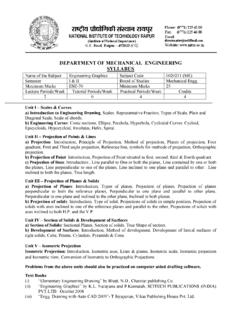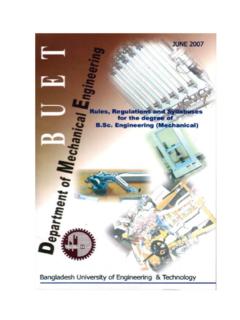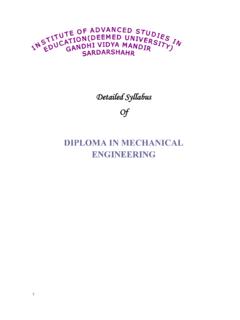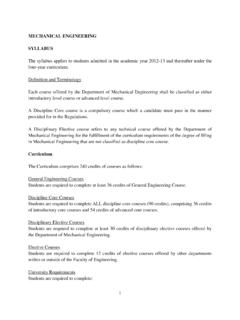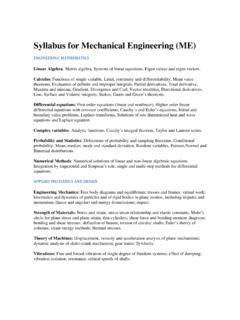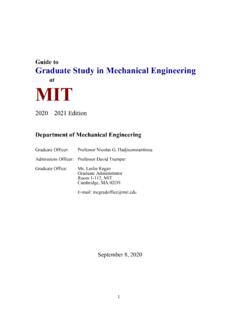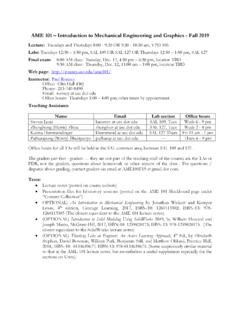Transcription of SYLLABUS FOR MECHANICAL ENGINEERING …
1 TS ECET-2018. SYLLABUS FOR MECHANICAL ENGINEERING . MATHEMATICS (50 Marks). Unit-I: Matrices Matrices of 3rd order: Types of matrices-Algebra of matrices-Transpose of a matrix- Symmetric, skew symmetric matrices-Minor, cofactor of an element-Determinant of a square matrix-Properties-Laplace s expansion-singular and non singular matrices-Adjoint and multiplicative inverse of a square matrix-System of linear equations in 3 variables-Solutions by Crammer s rule, Matrix inversion method,-Gauss-Jordan methods. Partial Fractions: Resolving a given rational function into partial fractions. Unit II: Trigonometry Properties of Trigonometric functions Ratios of Compound angles, multiple angles, sub multiple angles Transformations of Products into sum or difference and vice versa Simple trigonometric equations Properties of triangles Inverse Trigonometric functions. Complex Numbers: Properties of Modulus, amplitude and conjugate of complex numbers, arithmetic operations on complex number Modulus-Amplitude form (Polar form)-Euler form (exponential form)-Properties- De Movire s Theorem and its applications.
2 Unit III: Analytical Geometry Straight Lines different forms of Straight Lines, distance of a point from a line, acute angle between two lines, intersection of two non- parallel lines and distance between two parallel lines. Circles-Equation of circle given center and radius, given ends of diameter-General equation- finding center and radius. Standard forms of equations of Parabola, Ellipse and Hyperbola . simple properties. Unit IV: Differentiation and its Applications Functions and limits Standard limits Differentiation from the First Principles . Differentiation of sum, product, quotient of functions, function of function, trigonometric, inverse trigonometric, exponential, logarithmic, Hyperbolic functions, implicit, explicit and parametric functions Derivative of a function with respect to another function-Second order derivatives . Geometrical applications of the derivative (angle between curves, tangent and normal) Increasing and decreasing functions Maxima and Minima (single variable functions) using second order derivative only Derivative as rate measure -Errors and approximations - Partial Differentiation Partial derivatives up to second order Euler s theorem.
3 Unit V: Integration and its Applications Indefinite Integral Standard forms Integration by decomposition of the integrand of trigonometric, algebraic, exponential, logarithmic and Hyperbolic functions Integration by substitution Integration of reducible and irreducible quadratic factors Integration by parts . Definite Integrals and properties, Definite Integral as the limit of a sum Application of Integration to find areas under plane curves and volumes of Solids of revolution Mean and RMS. value. Unit VI: Differential Equations Definition of a differential equation-order and degree of a differential equation- formation of differential equations-solution of differential equation of the type first order, first degree, variable-separable, homogeneous equations, exact, linear differential equation of the form dy/dx + Py = Q, Bernoulli s equation, nth order linear differential equation with constant coefficients both homogeneous and non homogeneous and finding the Particular Integrals for the functions eax, xm, sin ax, cos ax.
4 Unit VII: Laplace Transforms and Fourier series Laplace Transforms and Inverse Laplace Transforms of Elementary functions. Shifting Theorems of LTs and ILTs. Define Fourier series, Euler's Formulae Over the interval (C, C+2 ).Even and odd functions and their Fourier series Unit VIII: Probability and Statistics Define Probability, addition Theorem, conditional Probability, Mean, Median, Mode, Mean deviation and standard deviation. PHYSICS (25 Marks). Unit-I: Units and dimensions: Physical quantity-fundamental and derived physical quantities- units-fundamental and derived units-SI units-multiples and sub-multiples in SI units-advantages of SI units-dimensions and dimensional formulae-dimensionless quantities- applications and limitations of dimensional analysis-problems. Unit-II: Elements of vectors: Scalar and vector quantities-examples-types of vectors- addition and subtraction of vectors-triangle law-parallelogram law and its cases-polygon law- resolution of a vector-unit vectors (i, j, k)-dot product and cross product of two vectors- characteristics of dot and cross products-examples- problems.
5 Unit-III: Kinematics and Friction Equations of motion-acceleration due to gravity-equations of motion under gravity- expressions for maximum height, time of ascent, time of descent, time of flight, velocity on reaching the point of projection in vertical motion--motion of a body projected from the top of a tower-projectile motion-examples-horizontal and oblique projections-expressions for maximum height, time of ascent, time of flight, horizontal range, problems. Friction- causes and types of friction-normal reaction-laws of friction-coefficients of friction- angle of friction-methods of reducing friction- advantages and disadvantages of friction- motion of a body over a rough horizontal surface, a smooth inclined plane and a rough inclined plane problems. Unit-IV: Work, Power and Energy Work, power and energy-definitions and units-potential and kinetic energies-examples and expressions-work-energy theorem-law of conservation of energy-problems.
6 Unit-V: Simple harmonic motion and Sound Definition-conditions of SHM-examples of SHM-expressions for displacement, velocity, acceleration, time period, frequency and phase of SHM-time period of a simple pendulum- seconds pendulum-problems. Sound-musical sound and noise-noise pollution-Effects and methods of control of Noise Pollution-Beats and echo's-problems-Doppler effect Explanation, and Applications - Acoustics of buildings-Reverberation-Sabine's formula- characteristics of a good building-problems. Unit-VI: Heat and Thermodynamics Expansion of gases-Boyle s law-Absolute scale of temperature-Charles laws-Ideal gas equation- Universal gas constant and its value-SI Units-problems-external work done by a gas- isothermal process-adiabatic process-first law of thermodynamics and its applications to isothermal process and adiabatic process-two specific heats of a gas-relation between Cp and Cv- problems-second law of thermodynamics and its applications.
7 Unit-VII: Modern physics Photoelectric effect explanation and its laws-applications of photoelectric effect (photocell)- Einstein's photoelectric equation critical angle and total internal reflection optical fibers - principle, working , types and applications-concept of super conductivity its properties and applications. CHEMISTRY (25 Marks). Unit I: Fundamentals of chemistry: Atomic structure: Introduction-Fundamental particles Bohr s theory Quantum numbers . Aufbau principle Hund s rule Pauli s exclusion principle- Electronic configurations of elements up to atomic number 20, shapes of s, p, d orbital's. Chemical Bonding: Introduction types of chemical bonds Ionic bond taking example of NaCl and MgO characteristics of ionic compounds and covalent bond taking example H2, O2, N2, HCl, characteristics of covalent compounds-Coordinate covalent bond- Metallic bond . Oxidation-Reductions:concepts of Oxidation-Reduction ,Oxidation number and its calculations, differences between oxidation number and Valency Unit-II: Solutions: Introduction solution classification of solutions, solute, solvent, concentration, mole concept, Molarity, Normality, equivalent weight using acids, bases and salts, numerical problems on Molarity and Normality.
8 Unit-III: Acids and Bases: Introduction theories of acids and bases Arrhenius, Bronsted . Lowry theory Lewis acid base theory Ionic product of water - pH and related numerical problems buffers solutions Applications. Unit IV: Principles of Metallurgy: Characteristics of metals and distinction between metals and non- metals. Definitions of metallurgy , ore, gangue, flux, slag concentration of ore-hand picking, levigation, froth floatation extraction of crude metal roasting calcination, smelting alloys . composition and uses of brass, German silver and nichrome. Unit-V: Electrochemistry: Conductors, insulators, electrolytes - Arrhenius theory of electrolytic dissociation electrolysis Faraday s laws of electrolysis- numerical problems Galvanic cell . standard electrode potential electro chemical series emf and numerical problems on emf of a cell. Unit VI: Corrosion: Introduction - factors influencing corrosion - electrochemical theory of corrosion- composition cell, stress cell and concentration cells rusting of iron and its mechanism prevention of corrosion by (a) coating methods, (b) cathodic protection (sacrificial and impressive voltage methods).
9 Unit-VII: Water Technology: Introduction soft and hard water causes of hardness types of hardness disadvantages of hard water degree of hardness, units and Numerical problems . softening methods permutit process ion exchange process qualities of drinking water . municipal treatment of water for drinking Osmosis and reverse Osmosis, advantages of reverse Osmosis. Unit-VIII: Polymers: Introduction polymerization types of polymerization addition , condensation polymerization with examples plastics types of plastics advantages of plastics over traditional materials Disadvantages of using plastics ,thermo plastics and thermo setting plastics differences between thermo plastics and thermo stetting plastics- preparation and uses of the following plastics: 1. Polythene, 2. PVC, 3. Teflon, 4. Polystyrene, formaldehyde Rubber natural rubber processing from latex Vulcanization Elastomers.
10 Butyle rubber Buna-s, Neoprene rubber and their uses. Unit-IX: Fuels: Definition and classification of fuels based on physical state and occurrence . characteristics of good fuel - composition and uses of gaseous fuels. (a) Water gas, (b) producer gas, (c) natural gas, (d) coal gas, (e) bio gas, (f) acetylene. Unit-X: Environmental Chemistry: Introduction environment understand the terms lithosphere, hydrosphere, atmosphere bio sphere, biotic component, energy component pollutant, receptor, sink, particulate, DO, BOD, Threshold limit value, COD- Air pollution - causes-Effects- Forest resources ,uses and over exploitation ,deforestation acid rain, green house effect ozone depletion control of Air pollution Water pollution causes effects control measures. Renewable and Non Renewable energy sources concept of ecosystem producers, consumers and decomposers Biodiversity ,threats to Biodiversity.
